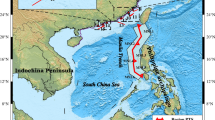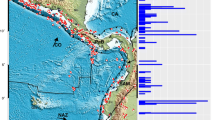Abstract
Currently, the most popular approach for assessing the tsunami hazard on a coast is the PTHA (Probabilistic Tsunami Hazard Assessment). In this preliminary study, we develop one of the variants of the SPTHA (Seismic PTHA) method, adapted to solving local tsunami zonation problems for near-field sources. The approach is applied to assessing the tsunami hazard of the Bechevinskaya Cove located on the eastern coast of the Kamchatka Peninsula in the northern part of Avachinsky Bay. We propose the method, algorithms and results of probabilistic assessment of the cove's tsunami hazard in order to determine the safest water areas, in which the values of the intensity measures (IMs) of tsunami will not exceed the specified threshold values with the given Average Return Periods (ARPs). The method includes analysis of seismotectonics of the region, construction of a catalog of model tsunamigenic earthquakes, determination of their statistical characteristics, scenario numerical modeling of the dynamics of tsunami waves, calculations of the values of IMs that can be exceeded with the given annual rates (ARs), namely, on average 1 time in 100, 500, 1000 years. Spatial distributions of the maximum wave heights and maximum velocities are provided for the ARs. Three configurations of the water area are considered, including the possibility of constructing protective structures, and conclusions are drawn about their influence on the tsunami hazard assessments in the cove.













Similar content being viewed by others
References
Baker JW (2008) An introduction to probabilistic seismic hazard analysis (PSHA). White Paper Version 1:3
Beisel SA, Gusiakov VK, Chubarov LB, Shokin YuI (2014a) Numerical simulation of the action of distant tsunamis on the russian far east coast // Izvestiya. Atmos Oceanic Phys 50(5):508–519. https://doi.org/10.1134/S0001433814050028
Beisel SA, Gusyakov VK, Rychkov AD, Chubarov LB, Shokin YuI (2014b) Algorithms and methodologies of numerical modeling of Tsunami waves runup to assess the characteristics of the waves runup on the Russian Far-East Coast. In: Proceedings of XII all-Russian conference “advanced technologies of hydroacoustics and hydrophysic”, Saint-Petersburg, Russia, pp 228–230 (in Russian)
Belotserkovsky OM, Davydov YuM (1982) Large Particle Method in Gasdynamics. Nauka, Moscow, p 392
Chubarov LB, Babailov VV, Beisel SA (2011) Program for calculating parameters of seismogenetic tsunami waves MGC. State Registration Certificate of Computer Program No. 2011614598
Cornell CA (1968) Engineering seismic risk analysis. Bull Seismol Soc Am 58(5):1583–1606
Davies G, Griffin J, Løvholt F, Glimsdal S, Harbitz C, Thio HK et al (2017) A global probabilistic tsunami hazard assessment from earthquake sources. Geol Soc London Spec Publ 456:219–244. https://doi.org/10.1144/SP456.5
De Risi R, Goda K (2017) Simulation-based probabilistic tsunami hazard analysis: empirical and robust hazard predictions. Pure Appl Geophys 174:3083–3106. https://doi.org/10.1007/s00024-017-1588-9
Di Giacomo D, Engdahl ER, Storchak DA (2018) The ISC-GEM earthquake catalogue (1904–2014): status after the extension project. Earth Syst Sci Data 10:1877–1899. https://doi.org/10.5194/essd-10-1877-2018
Dogan GG, Yilmaz N, Yalciner AC, Yucemen MS (2020) Tsunami hazard assessment for Izmir Bay, Turkey. Conference Paper, Conference: 16th European Conference on Earthquake Engineering At: Thessaloniki, Greece. June 2020.
Mitchel DP (1991) Spectrally optimal sampling for distribution ray tracing. SIGGRAPH Comput Graph 25(4):157–164. https://doi.org/10.1145/127719.122736
Flouri ET, Dougalis VA and Synolakis CE (2016) Numerical modeling of tsunamis and tsunami vulnerability analysis for Heraklion, Crete // Math. Meth. Appl. Sci. Special Issue Paper doi: 10.1002 / mma.4134.
González FI, Geist EL, Jaffe B, Kânoğlu U, Mofjeld H, Synolakis CE, Titov VV, Arcas D, Bellomo D, Carlton D, Horning T (2009) Probabilistic tsunami hazard assessment at seaside, Oregon, for near-and far-field seismic sources. J Geophys Res Ocean. https://doi.org/10.1029/2008JC005132
Grezio A, Babeyko A, Baptista MA, Behrens J, Costa A, Davies G, Thio HK (2017) Probabilistic tsunami hazard analysis: multiple sources and global applications. Rev Geophys 55:1158–1198. https://doi.org/10.1002/2017RG000579
Gusev OI, Chubarov LB (2018) On the use of telescopic nested grids in computations of tsunami propagation. In: Proceedings of XIV All-Russian conference “Advanced technologies of hydroacoustics and hydrophysics”. Saint-Petersburg, Russia, pp 224–226
Gusiakov VK (1978) Residual displacements on the surface of elastic half-space. Conditionally Correct Problems of Mathematical Physics in Interpretation of Geophysical Observations. Vychisl. Tsentr Sib. Otdel. RAN, Novosibirsk, pp 23–51
Gusiakov VK (2016) Tsunamis on the Russian pacific coast: history and current situation. Russ Geol Geophys 57(9):1259–1268. https://doi.org/10.1016/j.rgg.2016.08.011
Gusiakov VK (2017) Methods and problems of tsunami hazard assessment of marine coasts. Fundamentalnaya i Prikladnaya Gidrofizika. 10(3):26–38. https://doi.org/10.7868/S2073667317030029
Gusiakov VK, Kikhtenko VA, Chubarov LB, Shokin YuI (2019) Regional tsunami hazard maps for the Far East coast of Russian Federation built in the framework of the PTHA methodology. Computational Tech 24(1):55–72. https://doi.org/10.25743/ICT.2019.24.1.005
Hall J (2006) GEBCO centennial special issue – Charting the secret world of the ocean floor: the GEBCO project 1903–2003. Mar Geophys Res 27:1–5. https://doi.org/10.1007/s11001-006-8181-4
Kim D-S, Jeong Y-H, Lee H-Y, Kim D-H and Hong S-J (2020) Using hypothetical tsunami scenarios to analyze tsunami inundation characteristics in the coastal city of Ulsan, South Korea. In: Malvárez, G. and Navas, F. (eds.), Proceedings from the International Coastal Symposium (ICS) 2020 (Seville, Spain). Journal of Coastal Research, Special Issue No. 95, pp. 1–5.
Kulikov EA, Ivashchenko AI, Medvedev IP, Yakovenko OI, Kovachev SA (2016) On tsunami hazard in the Arctic Region. Arctic Ecol Economy 3(23):38–49
Kurkin A, Pelinovsky E, Choi BH, Lee JS (2004) A comparative estimation of the tsunami hazard for the Russian coast of the Sea of Japan based on numerical simulation //. Oceanology 44(2):163–172
LeVeque RJ, Berger MJ et al. Clawpack software. www.clawpack.org (http://www.clawpack.org) (accessed 15 August 2019).
Lorito S, Selva J, Basili R, Romano F, Tiberti MM, Piatanesi A (2015) Probabilistic hazard for seismically induced tsunamis: accuracy and feasibility of inundation maps. Geophys J Int 200:574–588. https://doi.org/10.1093/gji/ggu408
Løvholt F, Fraser S, Salgado-Gálvez M et al. (2019) Global Trends in Advancing Tsunami Science for Improved Hazard and Risk Understanding. Contributing Paper to GAR, 50 p.
MacCormack RW (1969) The effect of viscosity in hypervelocity impact cratering. AIAA Paper. https://doi.org/10.2514/2.6901
Molchan GM, Keilis-Borok VI, Ye V (1970) Seismicity and principal seismic effects. Geophys J r Astr Soc 21(3–4):323–335. https://doi.org/10.1111/j.1365-246X.1970.tb01795.x
Morin P, Porter C, Cloutier M et al (2016) ArcticDEM, a publically available, high resolution elevation model of the Arctic. EGU Gen Assem Conf Abstr 18:8396
Okada Y (1985) Surface deformation due to shear and tensile faults in a half-space. Bull Seismolog Soc Am 75(4):1135–1154
Papazachos BC, Scordilis EM, Panagiotopoulos DG, Papazachos CB, Karakaisis GF (2004) Global relations between seismic fault parameters and moment magnitude of earthquakes. Bull Geological Soc Greece 36:1482–1489. https://doi.org/10.12681/bgsg.16538
Park H, Cox DT (2016) Probabilistic assessment of near-field tsunami hazards: inundation depth, velocity, momentum flux, arrival time, and duration applied to Seaside. Oregon Coast Eng 117:79–96. https://doi.org/10.1016/j.coastaleng.2016.07.011
Park H, Cox DT, Barbosa AR (2018) Probabilistic tsunami hazard assessment (PTHA) for resilience assessment of a coastal community. Nat Hazards 94(3):1117–1139. https://doi.org/10.1007/s11069-018-3460-3
Pinegina TK, Bazanova LI (2016) New data on characteristic of historical tsunami on the coast of Avacha Bay (Kamchatka). Bull Kamchatka reg as Edu-sci center Earth sci 31(3):5–17.
Pinegina TK, Bazanova LI, Zelenin EA, Bourgeois J, Kozhurin AI, Medvedev IP, Vydrin DS (2018) Holocene tsunamis in Avachinsky Bay, Kamchatka. Russia Pure Appl Geophys 175(4):1485–1506. https://doi.org/10.1007/s00024-018-1830-0
Ren Y, Wen R, Zhou B, Shi D (2010) Deterministic analysis of the tsunami hazard in China //. Sci Tsunami Haz 29(1):32–42
Rychkov AD, Beisel SA, Chubarov LB (2013) Computer program: Module for calculation of runup of tsunami waves on a coast RunUp-LP. State Registration Certificate of Computer Program No. 2013617980
Shokin YuI, Babailov VV, Beisel SA, Chubarov LB, Eletsky SV, Fedotova ZI, Gusyakov VK (2008) Mathematical modeling in application to regional tsunami warning systems operations. In: E.Krause et al. (Eds.): Comp. Science & High Perf. Computing III, Notes on Numerical Fluid Mechanics and Multidisciplinary Design (101), pp. 52–68. Doi: https://doi.org/10.1007/978-3-540-69010-8_6
Shokin YI, Beisel SA, Rychkov AD, Chubarov LB (2015) Numerical simulation of the tsunami run-up on the coast using the method of large particles. Math Models Comput Simul 7:339–348. https://doi.org/10.1134/S2070048215040109
Sørensen MB, Spada M, Babeyko A, Wiemer S, Grünthal G (2012) Probabilistic tsunami hazard in the Mediterranean Sea //. J Geophys Res 117:B01305. https://doi.org/10.1029/2010JB008169
Storchak DA, Di Giacomo D, Bondár I, Engdahl ER, Harris J, Lee WHK, Villaseñor A, Bormann P (2013) Public release of the ISC-GEM global instrumental earthquake catalogue (1900–2009). Seism Res Lett 84(5):810–815. https://doi.org/10.1785/0220130034
Storchak DA, Di Giacomo D, Engdahl ER, Harris J, Bondár I, Lee WHK, Bormann P, Villaseñor A (2015) The ISC-GEM global instrumental earthquake catalogue (1900–2009): introduction. Phys Earth Planet Int 239:48–63. https://doi.org/10.1016/j.pepi.2014.06.009
Tinti S, Tonini R, Bressan L, Armigliato A, Gardi A, Guillande R, Valencia N, Scheer S (2011) Handbook of tsunami hazard and damage scenarios, JRC scientific and technical reports, EUR 24691 EN, JRC61463. Luxembourg. https://doi.org/10.2788/21259/
Tonini R, Armigliato A, Pagnoni G, Zaniboni F, Tinti S (2011) Tsunami hazard for the city of Catania, eastern Sicily, Italy, assessed by means of worst-case credible tsunami scenario analysis (WCTSA) Nat. Hazards Earth Syst Sci 11:1217–1232. https://doi.org/10.5194/nhess-11-1217-2011
Wronna M, Omira R, Baptista MA (2015) Deterministic approach for multiple-source tsunami hazard assessment for Sines, Portugal. Nat Hazards Earth Syst Sci 15:2557–2568. https://doi.org/10.5194/nhess-15-2557-2015
Zayakin YA and Luchinina AA (1987). Catalogue tsunamis on Kamchatka. In (p. 51). Obninsk: Vniigmi-Mtsd (Booklet in Russian).
Acknowledgements
The work was supported by the Program of the Presidium of RAS No. 27 ‘Fundamental problems of solving sophisticated practical problems using supercomputers’, project 0316-2018-0010 (head L.B. Chubarov). Data on tsunami deposits in Avachinsky Bay were obtained with the financial support of Russian Ministry of Education and Science (grant # 14.W03.31.0033 to N. Shapiro); the manuscript preparation was supported by the state assignment IViS FEB RAS #0282-2019-0005. The construction of the catalog of model tsunamigenic earthquakes was supported by the state assignment IEPT RAS AAAA-A19-119011490129-0.
Funding
The work was supported by the Program of the Presidium of RAS No. 27 ‘Fundamental problems of solving sophisticated practical problems using supercomputers’, project 0316–2018-0010. Data on tsunami deposits in Avachinsky Bay were obtained with the financial support of Russian Ministry of Education and Science (grant # 14.W03.31.0033 to N. Shapiro), the manuscript preparation was supported by the state assignment IViS FEB RAS #0282–2019-0005. The construction of the catalog of model tsunamigenic earthquakes was supported by the state assignment IEPT RAS AAAA-A19-119011490129–0.
Author information
Authors and Affiliations
Corresponding author
Ethics declarations
Conflicts of interest
The author declares no conflict of interest.
Additional information
Publisher's Note
Springer Nature remains neutral with regard to jurisdictional claims in published maps and institutional affiliations.
Appendix 1
Rights and permissions
About this article
Cite this article
Chubarov, L.B., Kikhtenko, V.A., Lander, A.V. et al. Technique of local probabilistic tsunami zonation for near-field seismic sources applied to the Bechevinskaya Cove (the Kamchatka Peninsula). Nat Hazards 110, 373–406 (2022). https://doi.org/10.1007/s11069-021-04951-y
Received:
Accepted:
Published:
Issue Date:
DOI: https://doi.org/10.1007/s11069-021-04951-y




